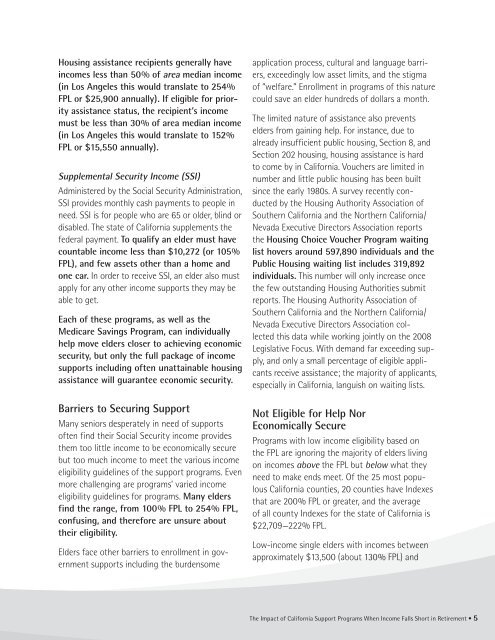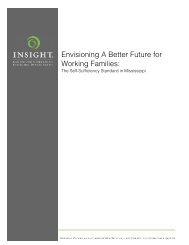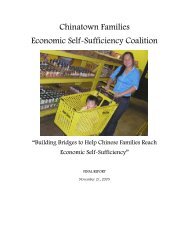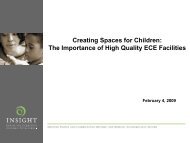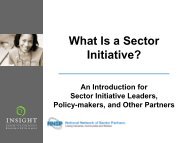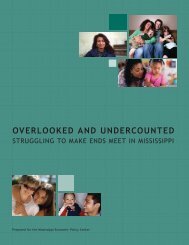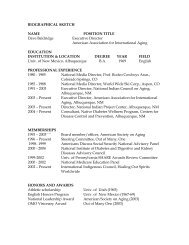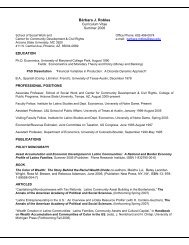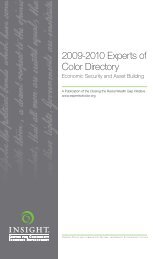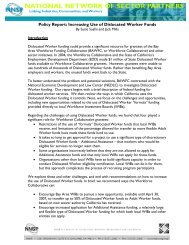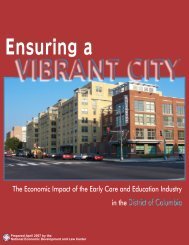Elders Living on the Edge - Insight Center for Community Economic ...
Elders Living on the Edge - Insight Center for Community Economic ...
Elders Living on the Edge - Insight Center for Community Economic ...
Create successful ePaper yourself
Turn your PDF publications into a flip-book with our unique Google optimized e-Paper software.
Housing assistance recipients generally have<br />
incomes less than 50% of area median income<br />
(in Los Angeles this would translate to 254%<br />
FPL or $25,900 annually). If eligible <strong>for</strong> priority<br />
assistance status, <strong>the</strong> recipient’s income<br />
must be less than 30% of area median income<br />
(in Los Angeles this would translate to 152%<br />
FPL or $15,550 annually).<br />
Supplemental Security Income (SSI)<br />
Administered by <strong>the</strong> Social Security Administrati<strong>on</strong>,<br />
SSI provides m<strong>on</strong>thly cash payments to people in<br />
need. SSI is <strong>for</strong> people who are 65 or older, blind or<br />
disabled. The state of Cali<strong>for</strong>nia supplements <strong>the</strong><br />
federal payment. To qualify an elder must have<br />
countable income less than $10,272 (or 105%<br />
FPL), and few assets o<strong>the</strong>r than a home and<br />
<strong>on</strong>e car. In order to receive SSI, an elder also must<br />
apply <strong>for</strong> any o<strong>the</strong>r income supports <strong>the</strong>y may be<br />
able to get.<br />
Each of <strong>the</strong>se programs, as well as <strong>the</strong><br />
Medicare Savings Program, can individually<br />
help move elders closer to achieving ec<strong>on</strong>omic<br />
security, but <strong>on</strong>ly <strong>the</strong> full package of income<br />
supports including often unattainable housing<br />
assistance will guarantee ec<strong>on</strong>omic security.<br />
Barriers to Securing Support<br />
Many seniors desperately in need of supports<br />
often find <strong>the</strong>ir Social Security income provides<br />
<strong>the</strong>m too little income to be ec<strong>on</strong>omically secure<br />
but too much income to meet <strong>the</strong> various income<br />
eligibility guidelines of <strong>the</strong> support programs. Even<br />
more challenging are programs’ varied income<br />
eligibility guidelines <strong>for</strong> programs. Many elders<br />
find <strong>the</strong> range, from 100% FPL to 254% FPL,<br />
c<strong>on</strong>fusing, and <strong>the</strong>re<strong>for</strong>e are unsure about<br />
<strong>the</strong>ir eligibility.<br />
<str<strong>on</strong>g>Elders</str<strong>on</strong>g> face o<strong>the</strong>r barriers to enrollment in government<br />
supports including <strong>the</strong> burdensome<br />
applicati<strong>on</strong> process, cultural and language barriers,<br />
exceedingly low asset limits, and <strong>the</strong> stigma<br />
of “welfare.” Enrollment in programs of this nature<br />
could save an elder hundreds of dollars a m<strong>on</strong>th.<br />
The limited nature of assistance also prevents<br />
elders from gaining help. For instance, due to<br />
already insufficient public housing, Secti<strong>on</strong> 8, and<br />
Secti<strong>on</strong> 202 housing, housing assistance is hard<br />
to come by in Cali<strong>for</strong>nia. Vouchers are limited in<br />
number and little public housing has been built<br />
since <strong>the</strong> early 1980s. A survey recently c<strong>on</strong>ducted<br />
by <strong>the</strong> Housing Authority Associati<strong>on</strong> of<br />
Sou<strong>the</strong>rn Cali<strong>for</strong>nia and <strong>the</strong> Nor<strong>the</strong>rn Cali<strong>for</strong>nia/<br />
Nevada Executive Directors Associati<strong>on</strong> reports<br />
<strong>the</strong> Housing Choice Voucher Program waiting<br />
list hovers around 597,890 individuals and <strong>the</strong><br />
Public Housing waiting list includes 319,892<br />
individuals. This number will <strong>on</strong>ly increase <strong>on</strong>ce<br />
<strong>the</strong> few outstanding Housing Authorities submit<br />
reports. The Housing Authority Associati<strong>on</strong> of<br />
Sou<strong>the</strong>rn Cali<strong>for</strong>nia and <strong>the</strong> Nor<strong>the</strong>rn Cali<strong>for</strong>nia/<br />
Nevada Executive Directors Associati<strong>on</strong> collected<br />
this data while working jointly <strong>on</strong> <strong>the</strong> 2008<br />
Legislative Focus. With demand far exceeding supply,<br />
and <strong>on</strong>ly a small percentage of eligible applicants<br />
receive assistance; <strong>the</strong> majority of applicants,<br />
especially in Cali<strong>for</strong>nia, languish <strong>on</strong> waiting lists.<br />
Not Eligible <strong>for</strong> Help Nor<br />
Ec<strong>on</strong>omically Secure<br />
Programs with low income eligibility based <strong>on</strong><br />
<strong>the</strong> FPL are ignoring <strong>the</strong> majority of elders living<br />
<strong>on</strong> incomes above <strong>the</strong> FPL but below what <strong>the</strong>y<br />
need to make ends meet. Of <strong>the</strong> 25 most populous<br />
Cali<strong>for</strong>nia counties, 20 counties have Indexes<br />
that are 200% FPL or greater, and <strong>the</strong> average<br />
of all county Indexes <strong>for</strong> <strong>the</strong> state of Cali<strong>for</strong>nia is<br />
$22,709—222% FPL.<br />
Low-income single elders with incomes between<br />
approximately $13,500 (about 130% FPL) and<br />
The Impact of Cali<strong>for</strong>nia Support Programs When Income Falls Short in Retirement • 5


